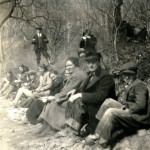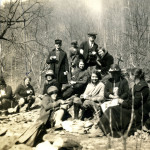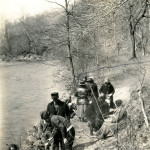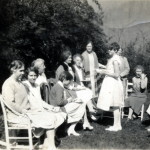Pine Mountain Settlement School
Series 09: BIOGRAPHY – Staff
Series 14: MEDICAL
Dr. Alfreda Withington, PMSS Physician, 1924-1931
Big Laurel Medical Settlement
Alfreda Bosworth Withington (1861-1951)
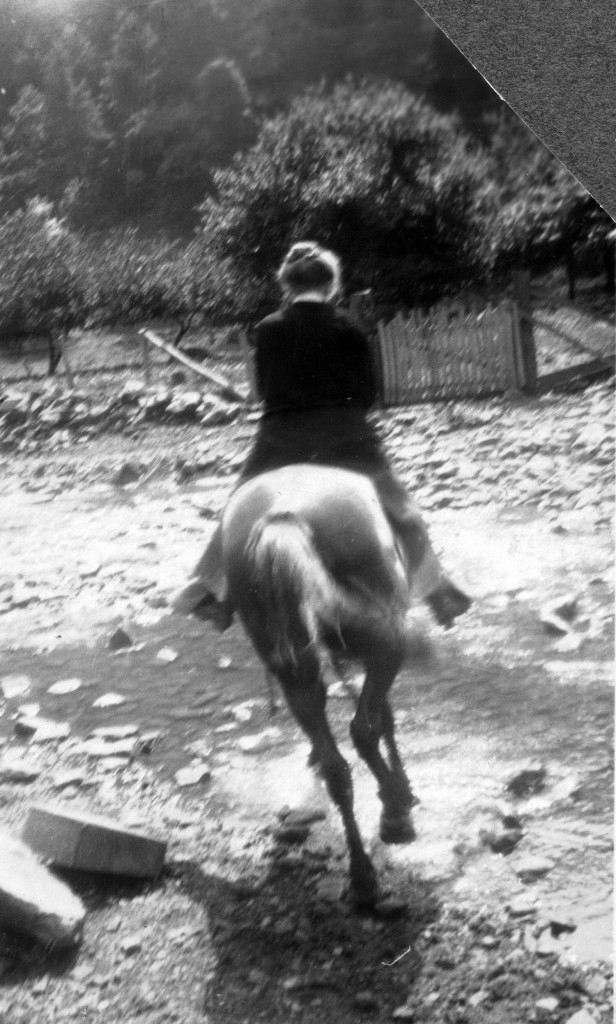
Dr. Alfreda Withington’s horse, “Billy,” was Alfreda’s faithful companion during her seven years at PMSS’s Big Laurel Medical Settlement. [big_laurel_3369.jpg]
TAGS: Dr. Alfreda Withington, social service, Big Laurel Medical Settlement, hospitals, medical practices, general medical practitioners, Tuberculosis Hospital, American National Red Cross, horseback travel, diphtheria, Dr. Elizabeth Blackwell, Dr. Grace Huse, influenza, woman doctor specializing in tuberculosis and practicing medicine in Appalachia in the early 1900s
Dr. ALFREDA WITHINGTON Staff
Big Laurel Medical Settlement Physician 1924-1931
In the early 1900s, it took a woman of great courage, persistence, resourcefulness, and tact to become a medical doctor. And a very intrepid and experienced doctor to qualify for an advertisement posted in a medical journal by the founders of the new Pine Mountain Settlement School. Such a person was Dr. Alfreda Bosworth Withington, who, at the end of her long career, worked for seven years at one of the two Medical Settlements established by Katherine Pettit and Ethel de Long Zande, founders of Pine Mountain Settlement School.
Dr. ALFREDA WITHINGTON: Her Family
In her memoir, Mine Eyes Have Seen (1941), Dr. Withington wrote that the goal of her parents was to provide her and her two brothers, George and James, with a good education. Her father (James Withington II), a principal of an academy in Hallowell, Maine, and later in Germantown, Pennsylvania, saw to it that the children grew up in a household full of books. Her mother, (nee Alfreda Bosworth), who missed her own chance to have an advanced education, influenced Alfreda to attend college. She also taught Alfreda “self-reliance and enterprise” and built in her “a steadying belief that obstacles could be overcome by will and perseverance,” attributes that enabled Alfreda to withstand the many adversities she faced throughout her career.
Dr. ALFREDA WITHINGTON: Her Education
After attending the Hicksite Quaker School in Germantown, Pennsylvania, Alfreda was admitted in 1877 to the school that her brother George had attended, Cornell University in Ithaca, New York. There she earned a Bachelor of Arts degree in 1881. Alfreda had already lost a sister and then her father in 1877 to tuberculosis, when her beloved older brother and mentor, George, contracted the disease. The helplessness she felt as she cared for him before he died led to her decision to study medicine.
After postgraduate science studies at Cornell, Alfreda matriculated in 1883 from the Women’s Medical College of the New York Infirmary, a small school founded by two women, Drs. Elizabeth and Emily Blackwell. [Dr. Elizabeth Blackwell, the first woman physician in the United States, began her interest in medicine while living in Asheville, NC, and went on to found the Women’s Medical College of New York, one of two colleges in the East that provided high-quality medical education for women.]
After graduation, Withington interned at the New York Infirmary for Women and Children, which, she wrote,
…not only gave me a wonderful opportunity for realizing that erudition without experience is of small value, but helped to broaden my understanding of human beings – an understanding essential to medical practice.
Withington’s application for a position with the Infirmary for Women and Children was rejected, as none of the male directors would agree to let her take the entrance examination. Disappointed at this rebuff, she took the advice of her mentor and traveled to Europe where she studied at various institutions in Vienna, Prague, Zurich, and Berlin. Again she was met with prejudice against women in the field of medicine but quietly persevered, often finding ways to work around rules or convince officials that she was capable and qualified. She learned enough of the language of each country to attend classes, watch the work of well-known physicians, and eventually perform surgery herself.
Dr. ALFREDA WITHINGTON: General Practitioner
When Alfreda, now Dr. Withington, returned home to the United States, she turned down offers of teaching positions in order to start her own practice. Her supervising doctor recommended that she move to an eastern town with a high altitude that would help her manage the “slight trouble” in one of her lungs. By 1891, she had selected Pittsfield in the Berkshire Hills of Massachusetts. She thrived as a general practitioner in this small town, enjoying friendships with both colleagues and townspeople. Although by this time she had 15 years of surgical experience, she felt that her choice to serve as a general practitioner was the right one, stating,
To be close to patients, to enjoy their confidence, to share their anxieties, to be helpful, is very satisfying, and many by their endurance of suffering, by their courage in facing the inevitable, set an example never to be forgotten.
Dr. ALFREDA WITHINGTON: Lady Doctor In Labrador
In 1906, Dr. Withington was in need of a restorative vacation and volunteered that summer as the first female doctor to work with Dr. Wilfred T. Grenfell, who founded the Mission of the Deep Sea Fisherman and established several hospitals and medical centers in Labrador. She was assigned to care for the “fisherfolk” of Blanc Sablon in Quebec, and later at Indian Harbor, Labrador. According to Dr. Grenfell, writing in the introduction to her biography, Mine Eyes Have Seen, “The Lady Doctor came, worked and conquered….” He knew that she was someone special on his staff. That was not always the case. Dr. Withington had to fight most of her life to have her gifts recognized by her fellow travelers, especially men. Grenfell recognized her talents.
Back in Pittsfield, MA she joined with other doctors to establish a tuberculosis hospital and later helped form the Berkshire Chapter of the newly incorporated American National Red Cross.
Dr. ALFREDA WITHINGTON: In France During WWI
By 1917 World War I was in progress, and she volunteered for service in France as a tuberculosis specialist under the auspices of the Red Cross. While there, she was later transferred to the Rockefeller Commission to work among civilians.
After another four years of arduous work with the war’s wounded and sick in France where she served as the Chief of the Franco-American Dispensary and Hospital at Dreux, she was asked to work with the Rockefeller Commission among the war refugees and immigrants displaced by WWI.
Dr. ALFREDA WITHINGTON: Seven Years at PMSS
After an attack of angina, she returned to Pittsfield but was no longer comfortable with her former “conventional” practice after all that she had recently experienced. Finally, a friend pointed out an ad in the Journal of the American Medical Association, placed by Miss Katherine Pettit and Mrs. Ethel de Long Zande, directors of the Pine Mountain Settlement School, seeking a “woman physician.”
Wanted, a woman physician for settlement work in the remote Kentucky mountains; all calls to be made on horseback, no other licensed physician within twenty-five miles.
She immediately applied for the position to replace Dr. Grace Huse who had served as the lead physician at the Big Laurel Medical Settlement. Writing to Miss Pettit, she noted “I know from experience that it takes a little while for patients to know me — Perhaps it is my New Englandism, but I mean well and they’ll find it out, given time.” (Letter, Feb. 9, 1924)
Delighted that “[t]he time had come when a woman physician was wanted,” Dr. Withington put her concerns for her personal health aside, secured a Kentucky medical license and, in 1924 at the age of 63, she headed for the Kentucky mountains by train from Louisville to Laden Trail and on to Pine Mountain. After an overnight at the School, she was introduced to a log cabin on the side of a mountain at Big Laurel Medical Settlement, on the headwaters of Greasy Creek, that was to be her home and office for the next seven years. Along with her staff: a nurse, welfare worker, and a “mountain girl,” she set about doing what she knew so very well, taking care of the sick. The nearest hospital, run by the U.S. Steel Corporation, was located in the mining town of Lynch, nearly 25 miles away. Serious charity cases were taken to Louisville using free passes from the Louisville and Nashville Railroad. To reach the train to Lynch or Louisville, a patient was carried on a stretcher over the mountain by a relay of men from the family and community.
Dr. Withington treated many of the deadly ailments that were common at that time in the mountains, such as tetanus, influenza, typhoid, trachoma, diphtheria, nephritis, pneumonia, and a chickenpox outbreak at Pine Mountain Settlement School. She was also kept busy with health concerns that seemed to be more prevalent in the mountains than elsewhere: hookworm and rheumatism. She and her nurse kept no regular office hours and spent much of their time traveling up and down steep trails on horseback to visit patients in their homes, all the while keeping an eye out for rattlesnakes, copperheads, stray farm animals, and bootleggers. The number of home deliveries of babies is not known but it was large. Many of the babies were named for her.
On night riding to a call on the back of a borrowed horse, Maude, (her trusted horse, “Billy” was out of commission), she carefully made her way in the dark on an emergency call to the home of Cora Craig whose smallest child had fallen in the fire and was badly burned. Dr. Withington, fearing to leave the child unattended spent the night and then saddled Maude for the trip home. Going down one of the steep trails the horse stumbled and she became the patient as she described it in her biography,
“…I struck almost squarely on my face. I remember the sensation of hurtling through the air and hearing a crash. Then there was a blank.
A mountain woman was standing over me when I came to. I had an awareness that something was wrong; putting my hand to my nose I felt it crunch, and it was bleeding terribly. I told the woman to give me my kit, and lying there I manipulated the grating bones, straightened them, and poked some gauze up my nostrils. Though faint from loss of blood there was nothing for me to do but remount and ride the four miles home. “
Verifying the ordeal, Ethel de Long wrote about the incident to Dr. Llewella Merrow, a physician who succeeded Withington. Hers was a precautionary tale to Dr. Merrow as she prepared to take on the same medical trails by horseback.
December 2, 1926
Dear Dr. [Llewella] Merrow:
I am so glad to have such a nice letter from you and to think you are wanting to jump on a nag and take a ride over the hills, Dr. [Ida] Stapleton seems to be enjoying it. She has been here a good deal the last week or so looking after Dr. [Alfreda] Withington. Did you know about her being thrown from her horse several weeks ago and breaking her nose? She was going back to Big Laurel, after being up at the Nolans’ looking after a boy who had been kicked in the stomach by a mule which he was driving across the mountain, and her horse stumbled and fell. When she came to she found herself lying in a pool of blood and realized that her nose was broken. This is the third time it has been broken. And so right there under the horse’s heels she set her nose, got on again and rode on to Big Laurel, and the next day went to Louisville to see a specialist. The one she saw–the finest in Louisville– said he couldn’t have set the nose any better himself. Isn’t she a lucky person? Well, then, when she came back she was so eager to get back to her cases, and had to walk about in rain and slush, and now she is lying up at the infirmary with diphtheria. She has been very sick indeed and has had several bad heart attacks, but we think the worst is over now. Her nephew came on from New York to be with her. Of course it will be many weeks before she can do anything now. Indeed we know she will not be able to go back to work again this winter and I think she is planning to go out as soon as she is able. We shall certainly feel lost without her.
As de Long described, she got herself patched up and went to Louisville to see a specialist and found that her malar bones were not smashed but two days later she was confronted with all the signs of a typical diphtheria infection and that did keep her down for weeks. Upon her recovery, however, she came straight back to the mountains where she welcomed Spring:
“I rode over mountainsides entirely covered with blue ‘woolly breeches,’ and saw between the trees the hazy blue of the more distant Cumberland ridges. That was the tapestry that nature once more spread out before me.”
Despite the dangers and discomforts of her outings, she wrote lovingly about the mountains and their forests, creeks, cliffs, and wildlife, and described the beauty of rhododendron, dogwood, holly, and laurel that grew along the way. Her ease in mingling with the mountain people and her love and respect for them were evident in her writings as she recounted various local gatherings and cultural events she enjoyed in her free time.
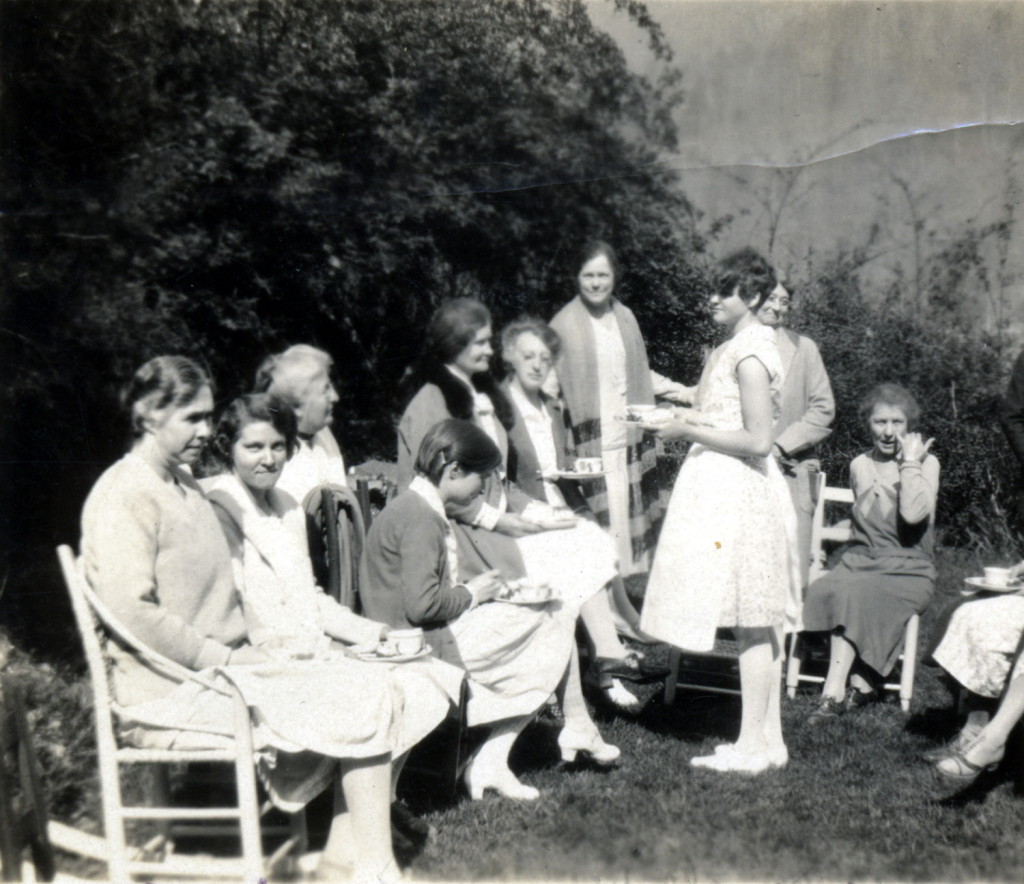
Tea on the lawn at Zande House. [Dogwood Breakfast?] , 1930. (l. to r.) Sally Loomis, a visitor Miss Taylor, Dr. Alfreda Withington, Miss Burbrick, Mrs.Burns, Miss Melville, Mrs. Barti…, Miss McDavid, Mrs. Bo…[?] [X_100_workers_2541.jpg]
Dr. ALFREDA WITHINGTON: Washington, DC and NYC
In 1931, she traveled to Washington, D.C., for what she intended to be a short respite. However, another attack of angina prevented her from returning to the mountains. At the end of her memoir, Dr. Withington wrote:
It was a tugging at my heart that I realized my work was over. Life there was so real in its ruggedness and simplicity. I shall think often of the kindness and hospitality….
My memories are rich: student days with their discouragements and small successes; the Old World with its glimpses of unfamiliar people and ancient landmarks; the bleak shores of Labrador and her hardy, friendly people; the War with its tragedies and its heroisms and, strangely enough, its humors; the dense forests of the Kentucky Mountains and their simple folk threading the endless narrow trails. All these hundreds of men and women I have known, and in many cases ministered to, have given me back a thousandfold whatever I have given.
By 1941, when her memoir, Mine Eyes Have Seen, was published, she was still residing in Washington, D.C.
In 1945, shortly after the publication of her memoir, Alfreda sent the following letter to Delia Creech, wife of Henry Creech and daughter-in-law of William and Sally Creech:
Dear Mrs. Creech,
I wonder how the summer has treated you. Mrs. Bullock [Katherine Pettit’s sister in Lexington] sent me a paper giving the hundredth anniversary celebration [actually 50th Anniversary?] It was very interesting – she seems to like the Benjamins as has everyone I’ve seen.
Are your son, who was in England, and Oma [Delia’s daughter who later became a doctor] still over there? — It will be a hard winter in Europe —
I was unfortunate enough to have to have an operation — was in the hospital from mid-October to mid-Nov. Am now settled here for the winter, but will require some weeks or months to get back my strength.
If you could send any rhododendron I wonder if you could get it away from where the railroad goes — The leaves were covered with a fine soot — and even though I washed each leaf carefully it had affected the green — I enjoyed it, however — but if it is just as easy to get it when it is clean it would be better. The sprays that shape are particularly nice. [Drawing]
I had a small parcel ready to send you when I went to the hospital but it is in a case not yet received — I shall be so interested to hear from you — I had hoped to see Miss Cobb, [Alice Cobb, a PMSS staff member] in Boston but didn’t run across her.
Much love,
Alfreda Withington
_____________________________________________________________________________________
She also wrote the following letter [n.d.] to Delia Creech which appears to have been written after the one above. Her letter again refers to Oma, Delia’s daughter, whom she mentored and who later became a doctor:
Allerton House 130 East 57th Street New York 22, N.Y.
Dear Delia — I suppose by this time Oma has made her visit and how happy you must have been to see her. Where will she live and will she continue her practice? It would be a pity to give it up after all her experience —
I am writing especially to ask if there is still a P.O. at Big Laurel — I want to send Betts Lewis something. Will you let me know and also will you tell me if you received a small black and white scarf [drawing of scarf] in the box with the pin and beads. I ask simply to know if everything goes through all right.
Next year in the Spring or Fall I am going to clear out my storage and I have there a saddle. I last used it in Arizona, but I doubt if I [will] ride again. Would you like it? My riding habit is too small for you, but could some member of your family use it? This is inquiring a long way ahead but if I know just where to send the things it will be easier when the time comes.
I am back here [New York] for the winter but New York is jammed as usual — much confusion and yet it has certain comforts.
Affectionate greetings
Alfreda Withington
**********
Dr. Alfreda Bosworth Withington was born in 1861 and died on October 1, 1951. She was buried in Pittsfield, Massachusetts.
GALLERY
- “En route with Dr. Withington and neighbors to visit a sick man.” [kingman_020b.jpg]
- Dr. Withington group en route to visit sick man down Greasy Creek. [kingman_019b]
- “Dr. Withington, top left with group on Greasy Creek en route to visit sick man.” [kingman_019a]
- Tea on the lawn at Zande House [Dogwood Breakfast ?] , 1930. (l. to r.) Sally Loomis, a visitor Miss Taylor, Dr. Alfreda Withington, Miss Burbrick, Mrs. Burns, Miss Melville, Mrs. Barti…, Miss McDavid, Mrs. Bo… [X_100_workers_2541.jpg]
See Also:
Dr. ALFREDA WITHINGTON Correspondence 1924-1925
Dr. GRACE HUSE Staff Biography
HENRY C. CREECH Community Biography
LINE FORK SETTLEMENT WORKERS Reports Publications Guide 1920-1941
HARRIET WALKER
MEDICAL Introduction
MEDICAL SETTLEMENT Big Laurel
|
Title |
Dr. Alfreda Withington |
|
Alt. Title |
Alfreda Bosworth Withington ; Dr. Withington ; |
|
Identifier |
|
|
Creator |
Pine Mountain Settlement School, Pine Mountain, KY |
|
Alt. Creator |
Ann Angel Eberhardt, Helen Hayes Wykle ; |
|
Subject Keyword |
Alfreda Withington, Alfreda Bosworth Withington, Pine Mountain Settlement School ; social service ; Katherine Pettit ; Ethel de Long ; Big Laurel Medical Settlement ; memoir ; James Withington II ; Hallowell, ME ; Germantown, PA ; Alfreda Bosworth ; Hicksite Quaker School ; Cornell University ; Ithaca, NY ; Women’s College of the NY Infirmary ; Elizabeth Blackwell ; Emily Blackwell ; NY Infirmary for Women and Children ; Women’s Hospital ; hospitals ; Vienna ; Prague ; Zurich ; Berlin ; medical practices ; general medical practitioners ; Pittsfield, MA ; Dr. Wilfred T. Grenfell ; Mission of the Deep Sea Fisherman ; Blanc Sablon, Quebec ; Indian Harbor, Labrador ; Tuberculosis Hospital ; American National Red Cross ; Berkshire Hills ; World War I ; France ; Rockefeller Commission ; American Medical Association ; Louisville, KY ; Laden Trail ; U.S. Steel Corporation ; Lynch, KY ; Washington, DC ; Philadelphia, PA ; New York, NY ; Boston, MA ; Arizona ; Delia Creech ; Henry Creech ; Mrs. Bullock ; The Benjamins ; Oma Creech ; Miss Cobb ; Betts Lewis ; Zande House ; Dogwood Breakfast(?) ; Sally Loomis ; Miss Burbrick ; Mrs. Burns ; Miss Melville ; Miss McDavid ; |
|
Subject LCSH |
Withington, Alfreda Bosworth, — 1861-1951. |
|
Date |
2004-06-26 |
|
Publisher |
Pine Mountain Settlement School, Pine Mountain, KY |
|
Contributor |
Robert Leach |
|
Type |
Text ; image ; |
|
Format |
Original and copies of documents and correspondence in file folders in filing cabinet. |
|
Source |
Series 09: BIOGRAPHY ; and Series 14: MEDICAL – Medical Settlement at Big Laurel |
|
Language |
English |
|
Relation |
Is related to: Pine Mountain Settlement School Collections, Series 09: BIOGRAPHY, and Series 14: MEDICAL. |
|
Coverage Temporal |
1861 – 1951 |
|
Coverage Spatial |
Pine Mountain, KY ; Harlan County, KY ; Hallowell, ME ; Germantown, PA ; Ithaca, NY ; New York, NY ; Vienna, Austria ; Prague, Czechoslovakia ; Zurich, Switzerland ; Berlin, Germany ; Pittsfield, MA ; Blanc Sablon, Quebec ; Indian Harbor, Labrador ; Berkshire Hills, MA ; France ; Louisville, KY ; Lynch, KY ; Washington, DC ; Philadelphia, PA ; Boston, MA ; Arizona ; |
|
Rights |
Any display, publication, or public use must credit the Pine Mountain Settlement School, Pine Mountain, KY. Copyright retained by the creators of certain items in the collection, or their descendants, as stipulated by United States copyright law. |
|
Donor |
Robert Leach |
|
Description |
Core documents, correspondence, writings, and administrative papers created by or addressed to Alfreda Bosworth Withington ; clippings, photographs, albums, books by or about Alfreda Bosworth Withington ; |
|
Acquisition |
2013-11-06 |
|
Citation |
“[Identification of Item],” [Collection Name] [Series Number, if applicable]. Pine Mountain Settlement School Institutional Papers. Pine Mountain Settlement School, Pine Mountain, KY. |
|
Processed By |
Helen Hayes Wykle ; Ann Angel Eberhardt ; |
|
Last Updated |
2007-06-28 hhw ; 2009-11-20 aae ; 2013-11-05 aae ; 2013-11-09 hhw ; 2017-03-07 hhw; 2019-05-10 hhw; 2020-04-25 aae ; 2023-10-11 aae ; |
|
|
Sources: “Alfreda Withington,” Series 09: Staff/Personnel. Pine Mountain Settlement School Institutional Papers. Pine Mountain Settlement School, Pine Mountain, KY. Internet resource. Writings by Dr. Withington: Withington, Alfreda. Mine Eyes Have Seen: A Woman Doctor’s Saga. New York: E.P. Dutton & Co., Inc, 1941. Print. [Four editions were published between 1941 and 1945, including a London publication by R. Hale, 1945.] Withington, Alfreda Bosworth. The Value of Caricature. Thesis (A. B.) Cornell University. May 1881. Print. Withington, Alfreda Bosworth. The Mountain Doctor. Boston, 1932. Print. Withington, Alfreda. “The Mountain Doctor [Part I].” Atlantic Monthly, 150:3 (September 1932) 257-267. Print. Withington, Alfreda. “The Mountain Doctor [Part II].” Atlantic Monthly, 150:4 (October 1932) 469-477. Print. Withington, Alfreda. “The Mountain Doctor [Part III].” Atlantic Monthly, 150:6 (December 1932) 768-774. Print. Withington, Alfreda. Letters from Alfreda Withington to Delia Creech. Archival material. Dr. Withington’s papers are included in these collections: Clelia Duel Mosher Papers. Stanford, CA: Hoover Institution Archives, Stanford University. Box/Folder 2:23, 1919-1920. Online Archives of California: http://www.oac.cdlib.org (accessed 2009-10-30). Internet resource. Gaffney, Patricia H. (Ed.), The Emily Howland Papers at Cornell University: A Guide to the Microfilm Publication, Ithaca, NY: Cornell University Library Division of Rare and Manuscript Collections, Carl A. Kroch Library, 1975. Dr. Al. B. Withington: Reel 4, Mar 1891 – 1900. Archival material. Dr. Withington is mentioned in the following publications: Chin, Eliza L. This Side of Doctoring: Reflections from Women in Medicine. Thousand Oaks, Calif: Sage Publications, 2002. Print. Kelly, Howard A. M.D. A Cyclopedia of American Medical Biography, Comprising the Lives of Eminent Deceased Physicians and Surgeons from 1610 to 1910, Volume 2. Philadelphia, PA: W.B. Saunders Company, 1912. Print. “Withington Alfreda Bosworth: 77-83.” The Ten-Year Book of Cornell University. (1908). Print. |
Return To:
BIOGRAPHY – A-Z
MEDICAL Guide
MEDICAL Staff Lists

